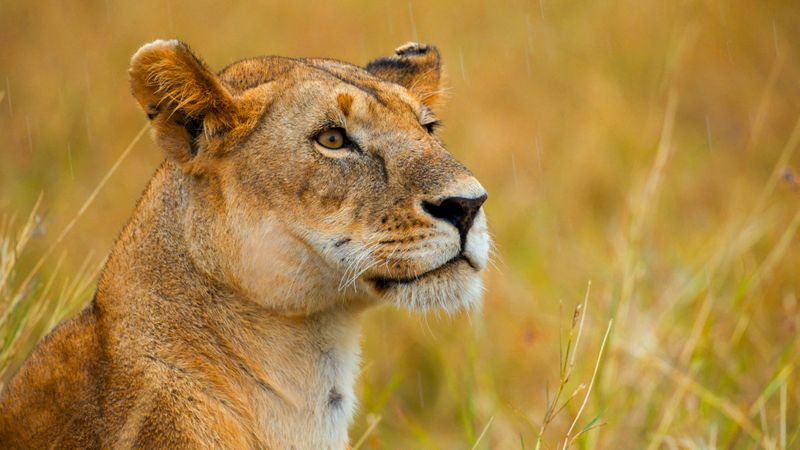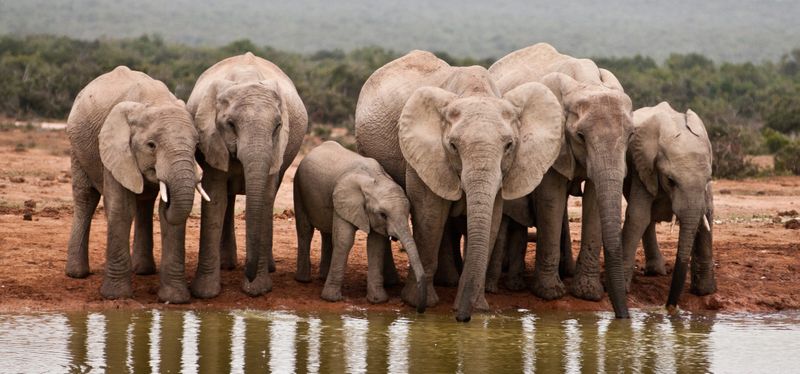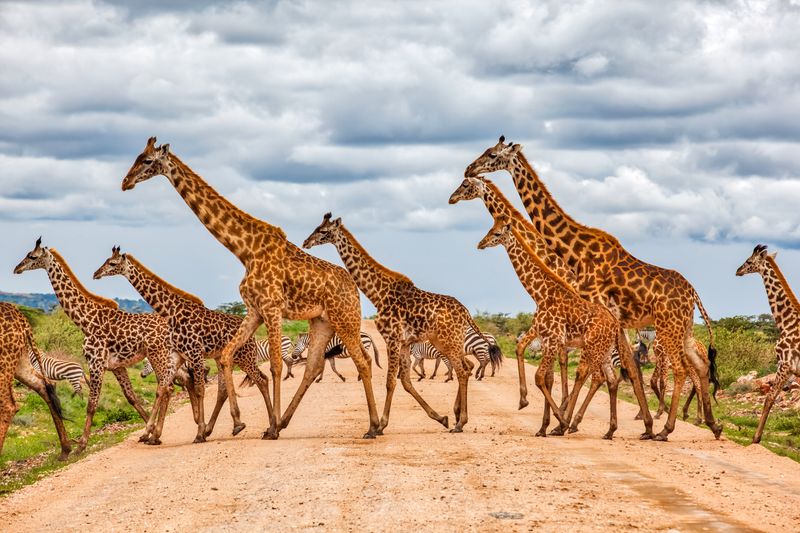Picture this: the first light of dawn stretching over a vast, whispering savannah. A lion’s roar echoes in the cool air, elephants appear like ancient statues in the mist, and somewhere nearby, a leopard watches unseen. This is the magic of an African safari—a journey that stirs something primal, powerful, and unforgettable. At Inspiring Vacations, we’re here to make that magic accessible, with curated tours designed to blend comfort, adventure, and authentic wildlife encounters.
Whether you're planning your first safari or returning for another taste of the wild, here’s your complete guide to experiencing the Big Five and beyond.
What are the Big Five?
The "Big Five" is a term that once described Africa's most respected and formidable animals. Today, it symbolises the ultimate wildlife experience for safari-goers around the world. These legendary species are:
Lions: Lions are most famously spotted in South Africa's Kruger National Park and Kenya's Masai Mara. Look for them lounging under acacia trees during the heat of the day, or following herds during early morning and evening drives.
Elephants: Huge elephant herds gather along the Chobe River in Botswana, offering some of Africa’s most dramatic viewing. In Kruger and Serengeti, solitary bulls and matriarch-led families are often found near watering holes, particularly in the dry season.
Buffalo: In Kruger, Chobe, and the Masai Mara, large herds of buffalo graze the open plains and gather near rivers. They're most active at dawn and dusk and are often seen cooling off in muddy pools during hot afternoons.
Leopards: Leopards are masters of camouflage, best spotted in tree-lined riverbeds and rocky outcrops. Sabi Sands near Kruger is world-renowned for leopard sightings, and the Serengeti’s Seronera Valley offers excellent opportunities too.
Rhinoceros: Black and white rhinos can be found in protected areas like Etosha National Park in Namibia and parts of Kruger National Park. Early morning game drives offer your best chance to catch a glimpse of these endangered giants grazing or wallowing near water.
Spotting all five on a single safari isn't guaranteed, but the search is part of the thrill.
Did you know
You’re most likely to spot all members of the Big Five during Africa’s dry season, when wildlife gathers around rivers and waterholes.
Where to see Africa’s Big Five on safari
If you’re wondering where you'll have the best chances of spotting the Big Five, these iconic destinations are featured on many of our tours.
Kruger National Park, South Africa
Few places rival the fame of Kruger National Park. Covering nearly two million hectares, Kruger offers exceptional Big Five encounters alongside cheetahs, giraffes, wild dogs, and more. One day you could be watching a pride of lions napping in the shade, the next spotting elephants crossing a dusty road right before your eyes.
Our 19 Day Ultimate African Safari includes expertly guided game drives through Kruger, ensuring you get the most out of every breathtaking moment. Read our article, a first timer’s guide to Kruger National Park, for more insights into this amazing location.
Serengeti National Park, Tanzania
A Serengeti safari is a rite of passage for wildlife lovers. Stretching across nearly 30,000 square kilometres, the Serengeti is one of the oldest and most celebrated ecosystems on Earth—a vast theatre where life and survival play out daily against endless golden plains.
The Serengeti is most famous for hosting the Great Migration, when over a million wildebeest, zebra, and gazelle traverse the landscape in search of fresh grazing. From December to July, depending on rainfall, herds move through different regions of the park, offering travellers front-row seats to dramatic river crossings, predator pursuits, and scenes of extraordinary resilience.
Even outside migration season, the Serengeti is alive with action year-round. Lions lounge atop rocky kopjes scanning the plains, elephant herds graze the open grasslands, and leopards slip through the trees, barely visible to the untrained eye. The sheer density of wildlife ensures that every game drive holds the promise of discovery.
Our carefully curated 11 Day Essential East Africa Safari takes you into the heart of this iconic reserve, with expert guides helping you uncover the hidden rhythms of one of Africa’s greatest natural stages.
Masai Mara, Kenya
The Masai Mara is often described as the crown jewel of African safaris, offering some of the richest and most concentrated wildlife viewing on the continent. Famed for its open grasslands and abundant predator populations, the Mara provides an exceptional chance to witness the Big Five, often all in a single day.
Between July and September, the plains come alive during the dramatic Great Migration. Over a million wildebeest, zebra, and gazelle pour into the Mara from the Serengeti, braving crocodile-infested rivers and ambushes from lions, leopards, and cheetahs. River crossings are heart-pounding spectacles, and open savannahs make it easy to follow predators as they hunt.
Beyond the migration season, the Mara remains a year-round safari destination. Resident lion prides, elephant herds, black rhinos, and elusive leopards offer spectacular sightings against sweeping vistas and dramatic African skies.
Chobe National Park and Okavango Delta, Botswana
Botswana offers some of Africa’s most remarkable and unspoiled safari experiences. Chobe National Park is world-renowned for its massive elephant populations—tens of thousands of elephants roam the park, often seen gathering along the Chobe River, particularly during the dry season. Early morning boat safaris offer a unique vantage point to observe these herds drinking, bathing, and interacting in their natural environment.
To the southwest lies the extraordinary Okavango Delta, a UNESCO World Heritage-listed wetland that transforms the Kalahari Desert into a labyrinth of waterways, islands, and floodplains. Here, travellers can glide silently through winding channels aboard a traditional mokoro canoe, spotting buffalo, lions, leopards, hippos, and a dazzling array of birdlife along the reed-lined banks. Game viewing in the Delta is as much about the journey as it is about the destination, with seasonal floods creating ever-changing wildlife experiences.
Note that while elephants and buffalo are commonly seen at Chobe, sightings of lions and leopards are less frequent, and rhinos are rare.
Etosha National Park, Namibia
Few places in Africa offer a landscape as striking as Etosha National Park. Dominated by the vast, shimmering Etosha Pan—a salt flat so large it’s visible from space—the park creates an almost otherworldly backdrop for wildlife viewing. During the dry season, life concentrates around the park’s natural and man-made waterholes, providing exceptional opportunities to see large herds of elephants, endangered black and white rhinos, lions, giraffes, and countless antelope species. Enjoy majestic sightings of these animals, but be aware that for a glimpse of buffalo, you’ll need to venture to other parks, such as Chobe National Park.
Unlike more densely vegetated parks, Etosha’s open plains make it easier to spot wildlife from a distance. Early morning and late afternoon are particularly rewarding times to visit waterholes, where patient observation can reveal incredible interactions between predator and prey.
Travel with us on the 13 Day Best of Namibia where you’ll explore Etosha’s rich wildlife scenes while enjoying the comfort and ease of expertly planned travel.
The best time for a Big Five Safari in Africa
When’s the best time to set out in search of Africa’s Big Five? It really depends on what you’re hoping to experience, whether you’re chasing clear, open landscapes for easy spotting or lush, dramatic backdrops for photography.
Dry season (June – October)
This is widely considered the prime time for Big Five safaris. With less vegetation and limited water sources, wildlife becomes much easier to spot as animals congregate around rivers, lakes, and waterholes. Expect crisp mornings, warm afternoons, and a high chance of sightings across parks like Kruger, Serengeti, Masai Mara, and Chobe. Take note, though, that this can vary by region; for example, East Africa's dry season is typically from June to October, while Southern Africa's is from May to September.
Green season (November – May)
The wet season transforms the landscapes into lush, vibrant scenes. It's calving season for many animals, meaning you may see newborns taking their first steps. While wildlife can be a little harder to spot through thick greenery, this time of year offers rich photographic opportunities, fewer tourists, and often lower travel costs. Birdwatchers will find it particularly rewarding, with migratory species arriving in full force.
Insider tip
For those hoping to witness the Great Migration river crossings in Kenya’s Masai Mara, aim for July to September, while Tanzania’s Serengeti sees dramatic movement earlier in the year, around March to May.
What to pack for your Big Five safari
Preparing for a Big Five safari means striking the right balance between comfort, practicality, and readiness for adventure. Whether you're journeying through the open plains of the Serengeti or tracking rhinos in Etosha, a thoughtful packing list for African safari adventures will make a huge difference. Every one of our safari destinations promises something special, and packing smart ensures you’re ready to enjoy every moment comfortably.
Here’s a practical list of essentials to pack for spotting African wildlife in the wild:
- Lightweight, neutral-coloured clothing (avoid bright colours)
- Wide-brimmed hat and high-SPF sunscreen
- Insect repellent (preferably with DEET) and a mosquito net to cover your face
- Sturdy walking shoes or boots
- Binoculars for wildlife viewing
- Light fleece or jacket for the cooler early mornings
- Dry bag for cameras and electronics
- Personal medications and basic first-aid supplies
- Refillable water bottle to stay hydrated
- Soft-sided luggage for easier transport on light aircraft (where applicable)
Top lodges and camps for Big Five Safaris
The magic of your African experience can be made even better by where you stay during your adventure. Here are a few accommodation favourites featured in our itineraries:
- Chobe Marina Lodge, Botswana: Relax on the Chobe River's edge after thrilling game drives.
- Okaukuejo Camp, Namibia: Iconic for its floodlit waterhole, perfect for nighttime sightings.
- Mara Simba Lodge, Kenya: Perfectly placed for exploring the Masai Mara’s rolling plains.
Wildlife photography tips for your African safari
Capturing your memories takes a little preparation. Here are our top tips for capturing those once-in-a-lifetime, breath-taking shots:
- Bring a zoom lens (200-400mm) for distant wildlife.
- Pack spare batteries and memory cards—you’ll need them!
- Consider procuring a dust cover for your camera equipment to protect against the elements during game drives.
- Respect the animals' space and wait for natural moments.
- Morning and evening light offer the richest colours.
- Familairise yourself with your camera gear before you go to avoid fiddling with settings at crucial moments.
What to know before you go on your African safari
Heading out on safari soon? Here's a fast guide to remember:
- Best African safari parks: Kruger, Serengeti, Masai Mara, Chobe, Etosha
- Best times to visit: Dry season for sightings, green season for landscapes
- Before you go: Ensure you check your recommended vaccinations are up to date and that you have purchased comprehensive travel insurace that covers this travel region.
- Packing list: Neutral clothes, sturdy boots, hat, sunscreen, binoculars, camera, malaria tablets
- Safari styles: Private luxury or small-group adventures—choose what best suits your interests and budget.
- Photography tips: Long lens, spare memory cards and battery, patience, and respect for these wild, majestic creatures.
Ready to start planning your African tour? There’s no experience quite like it. The stillness of dawn broken by a lion’s roar, the ancient path of elephants across dusty plains, the feeling of wonder that stays with you long after you return home.
Explore Botswana, Kenya, Madagascar, Namibia, South Africa, Tanzania, Uganda, and Zimbabwe with expertly designed tours that bring Africa’s incredible landscapes and wildlife to life. Whether you're chasing the Big Five, witnessing the Great Migration, or exploring off-the-beaten-path wonders, we’ll help you find the right adventure for you.
The wild heart of Africa is calling—are you ready to answer?





